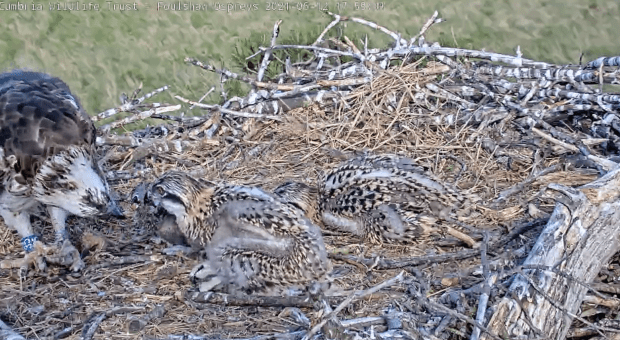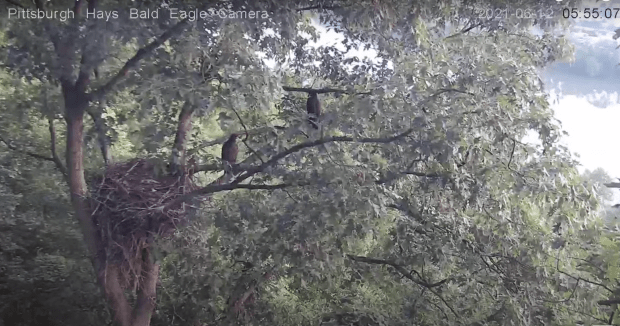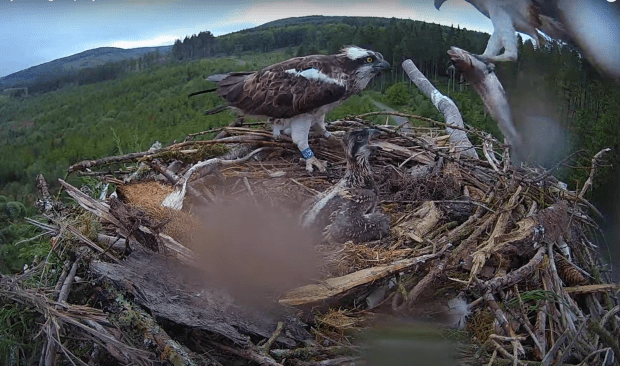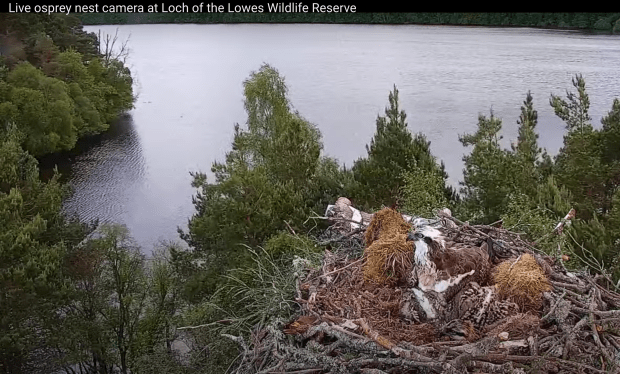It seems like it has been a pretty good day in Bird World.
The two little ospreys on the Cowlitz Nest had plenty of food today and nice crops albeit one of them had a bigger crop than the other. But, hey! I am not complaining. Fish is fish and they both ate really well. So did their Mom! Yippeee.
The little ones really blend into that nest with that bright sun. The one is in profile and the other is still being fed by Electra. And, of course, Wattsworth is hovering in case there is fish left! Can you hear me growling? Electra has done really well eating along with the two chicks and using up every morsel of the fish.

Now this Bob has a bit of a crop, too. He is going to drop it shortly. Wish he had done now and turned to get some more fish. For some reason this chick does not eat as much as the other.

Little Bob on the Foulshaw Moss Nest was right up there today with his big siblings – all standing in line nicely. Blue 35 is doing a fantastic job keeping those kiddos in line.

Little Tiny Bob has figured out where the ‘sweet spot’ is for feeding. Good for him. He has a lot of growing to do but, already, he is getting his beautiful curved feathers. What a cute little one.

Jack brought Tiny Tot a fish at 11:57:26 and then the rain started falling. Tiny really earns that fish. All day he has had to contend with adult intruders. He is doing an amazing job keeping those adults moving off that nest. Here is a short video of Tiny Tot getting one adult off the nest. That adult had the nerve to dive bomb Tiny!
Over at the The Landings Nest on Skidaway Island (Savannah) the second chick has fledged. That happened this morning at 6:13:51. By 8:50 both were on the nest having some breakfish. Scarlett and Rhett do not seem to be in any hurry for these two gorgeous ospreys to leave the area. Food arrives in good time to keep them on the nest and practising their flying skills before taking off for good.

There was quite a bit of excitement over in the UK today related to Ospreys. The 150th juvenile to fledge from Rutland Water has returned today for the first time. It is Male 056 hatched on the 13th of May 2019, one of four chicks of Maya and Blue 33 (11). 056 was seen in January 2020 in The Gambia. Wow! That really points to the success of their reintroduction programme.
Now to celebrate the translocation project of Poole Harbour. Translocation is when young birds are taken, at a certain age, and moved to a different location to try and establish an osprey colony where there is none. Such was the situation of Poole Harbour. In an earlier blog, I told you how Roy Dennis worked with the Poole Harbour Ospreys to introduce birds from Scotland to Poole Harbour. Remember, male birds normally return to the area of their natal nest to breed while females go elsewhere. The celebration is not happening at Poole Harbour per se but over in Glaslyn in Montgomeryshire Wales. There is the nest of Mrs G and Aran and then there is the PC nest. Z2 is the 2019 hatch of Monty and Telyn and his mate is Poole Harbour 014. And, while there are no images available, boots on the ground note that the behaviour in the nest has changed and it looks like there could be two hatches now! There is really good DNA in those chicks – lucky youngsters!
And everyone is wondering what in the world is going on in Missoula, Montana. Iris had the most handsome visitor – a three year old juvenile returnee visiting on her nest. His name is Congo 4C and he was hatched at the Dunrovin Nest in Missoula in 2018 just when Iris was taking care of her last ever chick, Le Le. This image shows Iris on the nest. She has been doing all manner of nestorations this morning. Then Louis has gotten a whiff of the visitor who is flying overhead with a fish! Like everyone else, I would love for this to get interesting!
Iris is on the left and Louis has just landed on the right. Overhead you can see Congo 4C coming with the fish – possibly for Iris? Now wouldn’t that be an interesting match? The oldest Osprey in the world with a 3 year old. And he is trying to show her he can fish.
Someone once told me that Ospreys do not have territories since they all fish in the same spots. That said, I have always understood that Iris’s nest is on Louis’s territory – that Louis more or less inherited it when Stanley died. But can a territory be divided? what about Starr and her chicks? My answer to that is that I wish Louis would take good care of his family at the baseball park and let Iris find herself a young man who wants to take care of her!

Here is Congo with Iris on the nest earlier:

Wow. Lots of things happening and then there is the fledge watch at the Redtail Hawk Nest of Big Red and Arthur. Laura Culley says it isn’t going to happen til next week. I hope she is right. K3 almost fludged today! But K2 has a bit of a sore or something causing its mouth not to close and a problem with an eye which Cornell experts are monitoring. I am really hoping that she has not cleaned her beak well and this is dried prey. The eye issue could relate to the chicks pecking at one another when they were younger???

K2 is on the left and K1 is on the right. K1 is distinguished by her very dark and thick belly band.

And then there is the adorable K3.

I am a real sucker for these tiny third hatches – for sure!
Thank you so much for joining me today. The ten goslings at Schloss Benkhausen in the White Stork Nest hatched and jumped to the ground this morning. You can see it here again:
Thank you to the following for their streaming cams where I get my screen shots and video clips: Schloss Benkhausen, Achieva Osprey, Cowlitz PUD, Cornell and Skidaway Audubon, Cornell and Montana Osprey Project, and the Cumbria Wildlife Trust.
































































































































